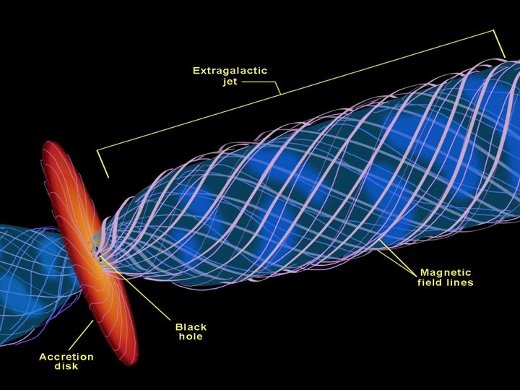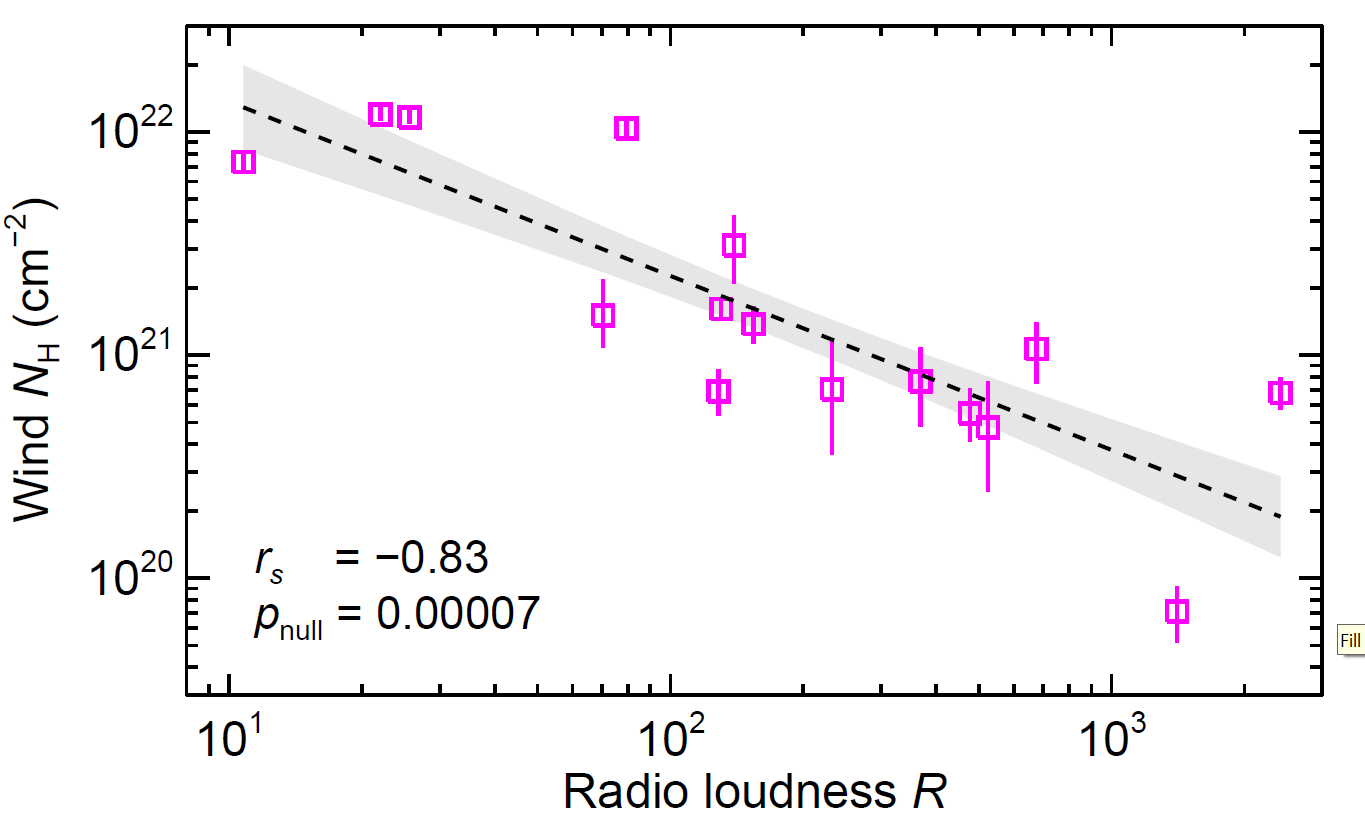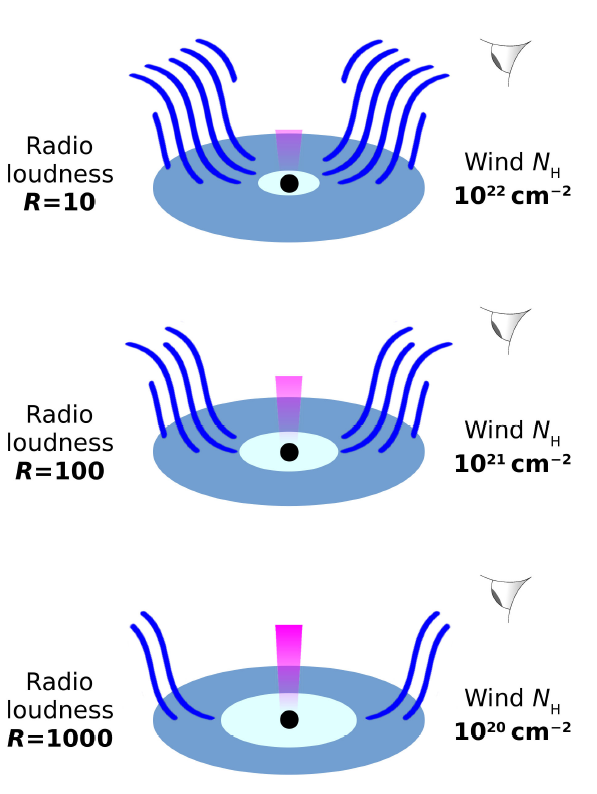Sterrenkundigen hebben een redelijk begrip van hoe sterrenstelsels kosmische straalstromen uitspuwen vanuit hun kern. Zulke actieve kernen blazen ook wind uit van geïoniseerd gas, waarvoor onderzoekers géén algemene verklaring hebben. SRON-astronomen hebben nu een correlatie gevonden tussen straalstromen en wind, wat op magnetische velden wijst als gezamenlijke oorzaak. Publicatie in Astronomy & Astrophysics.

Astronomen vermoeden dat elk sterrenstelsel een superzwaar zwart gat herbergt in zijn kern, zoals die in M87. Met een massa van miljoenen zonnen spelen deze zwarte gaten een sleutelrol in de evolutie van sterrenstelsels. Sommige zwarte gaten verorberen enorme hoeveelheden sterrenstof en gas uit hun omgeving. Deze Active Galactic Nuclei (AGN) spugen dat materiaal gedeeltelijk weer uit in de vorm van wind en straalstromen—zogenoemde jets. Sterrenkundigen hebben een tamelijk solide idee over het mechanisme achter jets, maar de wind blijft een mysterie.

Gezamenlijk mechanisme
Magnetische velden spelen een belangrijke rol in een breed scala aan objecten in het heelal. In AGN genereert het magnetische veld jets van relativistische deeltjes in tegengestelde richtingen langs de rotatie-as van hun zwarte gat (zie header image). SRON-astronomen Missagh Mehdipour en Elisa Costantini hebben nu een relatie gevonden tussen AGN-wind en jets, wat duidt op een gezamenlijk aandrijfmechanisme. Er blijkt een omgekeerde correlatie te zijn tussen de radiostraling vanuit de jets en de hoeveelheid gas in de AGN-wind langs onze zichtlijn (zie figuur 2). Afhankelijk van de rotatie van het zwarte gat en de configuratie van het magnetisch veld, is het uitgaande vermogen ongelijk verdeeld over de jets en de wind. Een krachtigere jet betekent zwakkere wind, en vice versa (zie figuur 3). De resultaten duiden erop dat de wind, net als jets, een magnetische aandrijving heeft. Mehdipour en Costantini bevestigden dit door andere mogelijke mechanismen uit te sluiten als oorzaak van de waargenomen correlatie.

Röntgen en radio
De SRON-onderzoekers gebruikten observaties van de XMM-Newton ruimtetelescoop om te kijken hoe de wind de vorm verandert van het AGN-röntgenspectrum langs onze gezichtslijn. Daaruit lazen ze de eigenschappen van de wind af, met speciale aandacht voor de hoeveelheid gas erin langs onze zichtlijn. Ze gebruikten radiometingen uit de literatuur om het vermogen van de jets te berekenen en modelleerden alle data met de SPEX code—ontwikkeld bij SRON door Jelle Kaastra en zijn groep.
Sample
‘Voor ons onderzoek moeten AGN helder genoeg schijnen in röntgen en onder een gunstige hoek staan,’ zegt Mehdipour. ‘Dat leidde tot een sample van zestien AGN. Hoewel onze ontdekte correlatie statistisch significant is met een kans van minder dan 1% op géén correlatie, is een groter sample nodig voor een bredere conclusie. Met toekomstige röntgentelescopen, vooral Athena, kunnen we de wind detecteren in zwakker stralende AGN. Dat zou ons sample vergroten en onze conclusie sterker maken.’
Publicatie
Missagh Mehdipour and Elisa Costantini, ‘Relation between winds and jets in radio-loud AGN‘, Astronomy & Astrophysics
———————————————————————————————
———————————————————————————————
Jets and winds from galaxy cores appear to share a common cause
Astronomers have a rough understanding of how galaxies emit jets from their core. Galaxy cores also blow out winds of ionized gas, for which researchers lack a general explanation. SRON astronomers have now found a correlation between jets and winds, suggesting magnetic fields as a common cause. Publication in Astronomy & Astrophysics.

Astronomers suspect that every galaxy harbors a supermassive black hole at its core, just like the recently photographed one in M87. With a mass of over a million suns, these black holes play a key role in the evolution of galaxies. Some black holes gobble up vast amounts of stardust and gas from their host galaxies. Those so-called Active Galactic Nuclei (AGN) spit out some of the material that is falling onto them in the form of jets and winds. Astronomers have a fairly established idea about the mechanism behind jets, but the winds remain a mystery.

Common mechanism
Magnetic fields are important players in a wide range of objects in the universe. In AGN the magnetic field drives jets of relativistic particles in opposite directions along the rotation axis of the black hole (see header image). SRON astronomers Missagh Mehdipour and Elisa Costantini have now found a relation between jets and winds, suggesting a common driving mechanism. There turns out to be an inverse correlation between the radio emission from the jet and the amount of gas in the AGN’s wind along our line of sight (see figure 2). Depending on the spin of the black hole and the configuration of the magnetic field, the outflowing power is distributed differently to the jet and the wind. A more powerful jet means a weaker wind, and vice versa (see figure 3). The results suggest that, just like jets, winds are magnetically driven. Mehdipour and Costantini confirmed this by excluding other possible mechanisms for the observed correlation.

X-ray and radio synergy
The SRON researchers used XMM-Newton observations to see how the wind alters the shape of the X-ray spectrum from the AGN along our line of sight. This enabled them to derive the parameters of the wind, particularly the amount of gas in it along our line of sight. They used radio measurements from the literature to calculate the power of the jets and modelled all data with the SPEX code—developed at SRON by Jelle Kaastra and his team.
Future prospects
‘For our investigation, AGN had to shine bright enough in X-rays and have a favourable inclination angle,’ says Mehdipour. ‘This means we ended up with sixteen AGN in our sample. Although our discovered correlation is statistically significant with a probability of no correlation much smaller than 1%, a larger sample is desirable for a more general characterization. Future X-ray telescopes, in particular Athena, will enable us to detect the wind in fainter AGN. This would increase the sample size and make our conclusion stronger.’
Publication
Missagh Mehdipour and Elisa Costantini, ‘Relation between winds and jets in radio-loud AGN‘, Astronomy & Astrophysics


